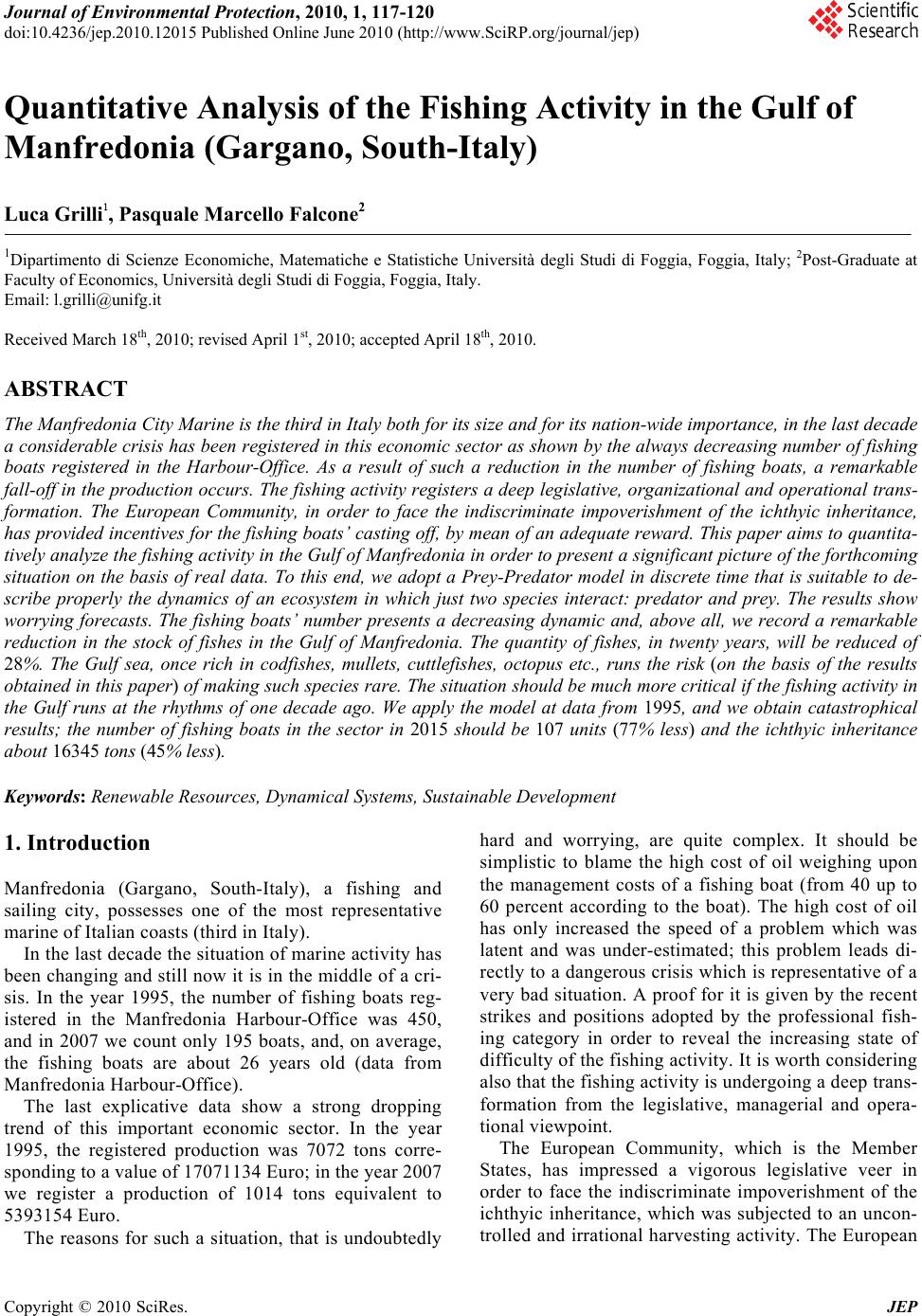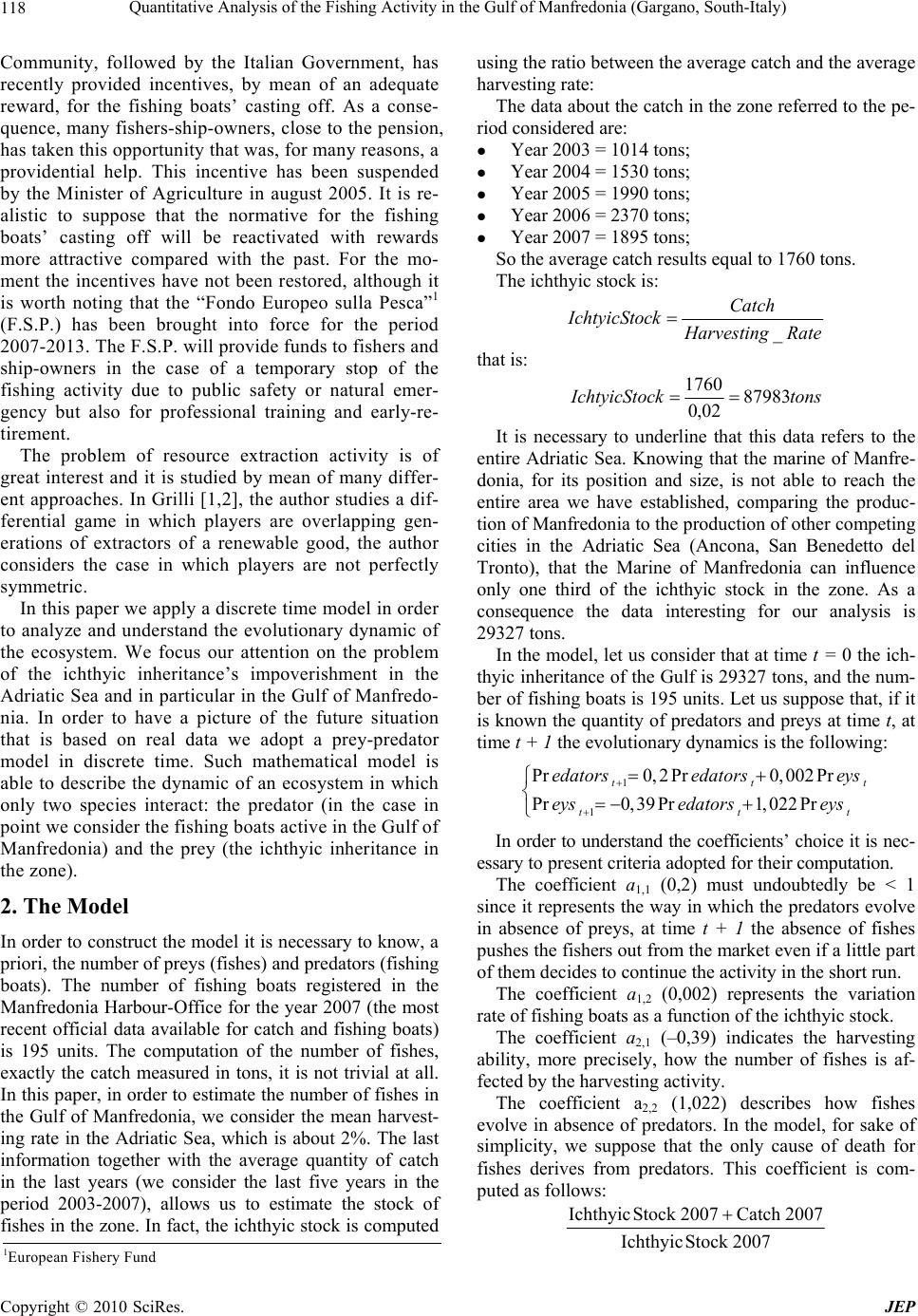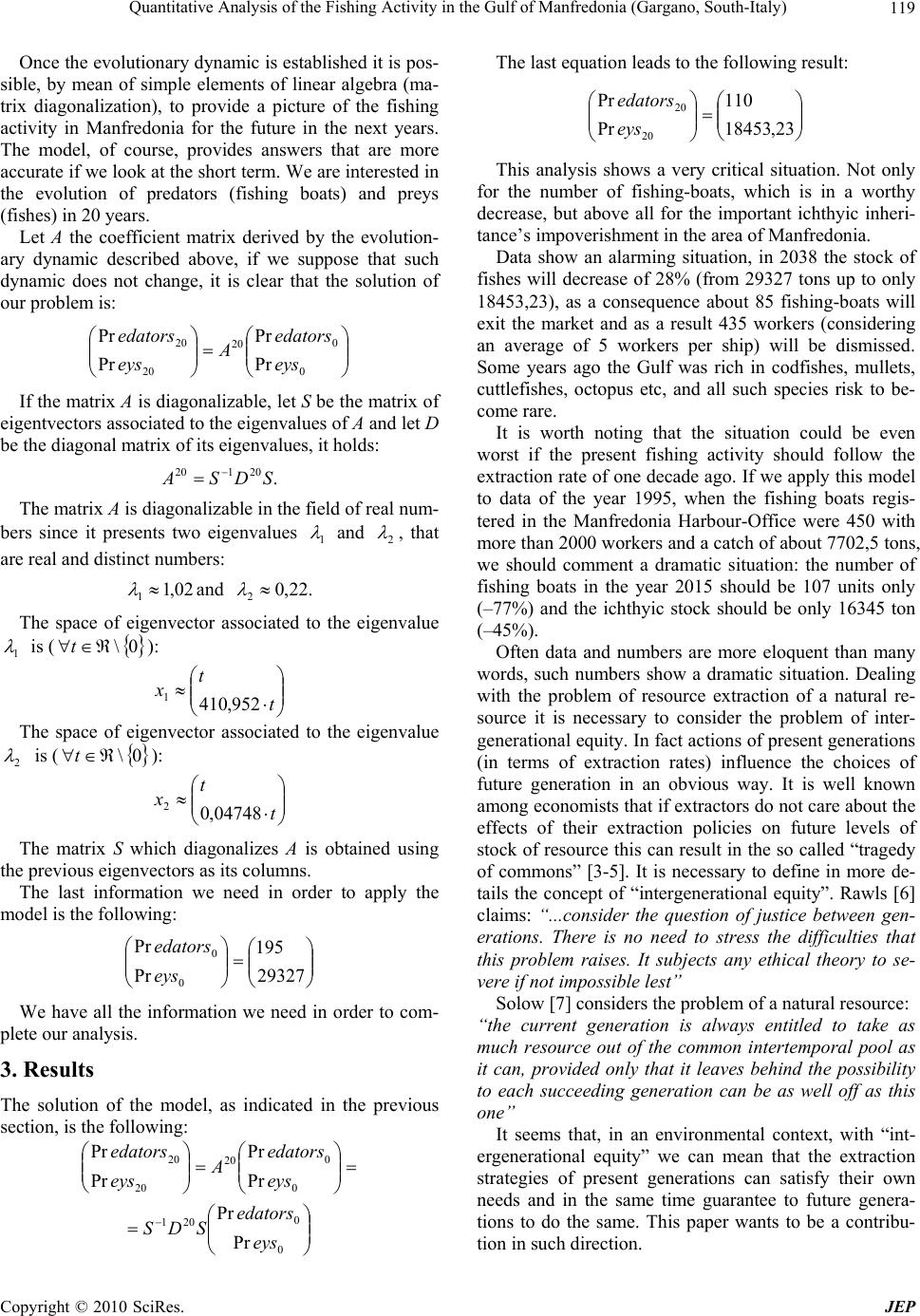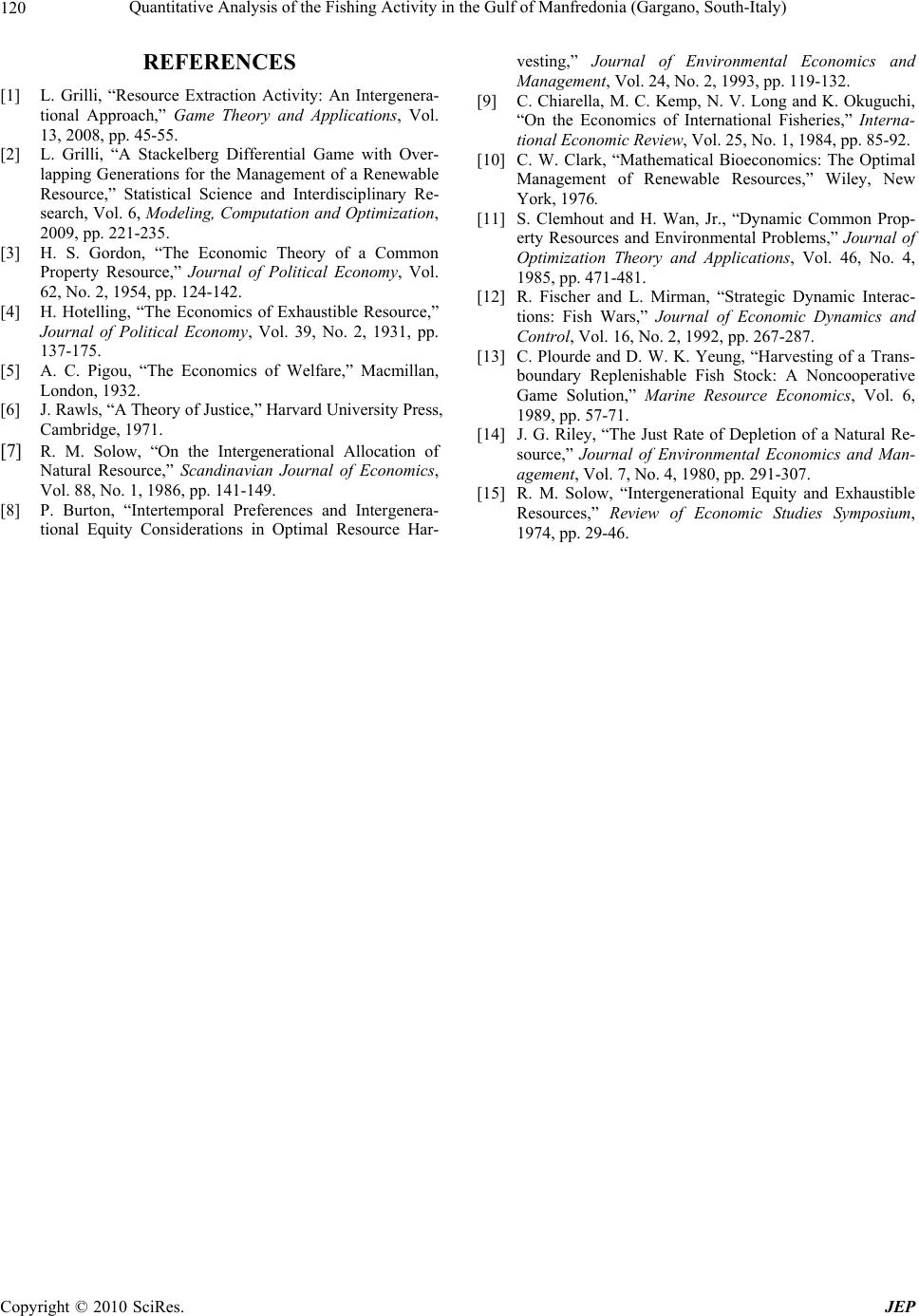Paper Menu >>
Journal Menu >>
 Journal of Environmental Protection, 2010, 1, 117-120 doi:10.4236/jep.2010.12015 Published Online June 2010 (http://www.SciRP.org/journal/jep) Copyright © 2010 SciRes. JEP 1 Quantitative Analysis of the Fishing Activity in the Gulf of Manfredonia (Gargano, South-Italy) Luca Grilli1, Pasquale Marcello Falcone2 1Dipartimento di Scienze Economiche, Matematiche e Statistiche Università degli Studi di Foggia, Foggia, Italy; 2Post-Graduate at Faculty of Economics, Università degli Studi di Foggia, Foggia, Italy. Email: l.grilli@unifg.it Received March 18th, 2010; revised April 1st, 2010; accepted April 18th, 2010. ABSTRACT The Manfredonia City Marine is the third in Italy both for its size and for its nation-wide importance, in the last decade a considerable crisis has been registered in this economic sector as shown by the always decreasing number of fishing boats registered in the Harbour-Office. As a result of such a reduction in the number of fishing boats, a remarkable fall-off in the production occurs. The fishing activity registers a deep legislative, organizational and operational trans- formation. The European Community, in order to face the indiscriminate impoverishment of the ichthyic inheritance, has provided incentives for the fishing boats’ casting off, by mean of an adequate reward. This paper aims to quantita- tively analyze the fishing activity in the Gulf of Manfredonia in order to present a significant picture of the forthcoming situation on the basis of real data. To this end, we adopt a Prey-Predator model in discrete time that is suitable to de- scribe properly the dynamics of an ecosystem in which just two species interact: predator and prey. The results show worrying forecasts. The fishing boats’ number presents a decreasing dynamic and, above all, we record a remarkable reduction in the stock of fishes in the Gulf of Manfredonia. The quantity of fishes, in twenty years, will be reduced of 28%. The Gulf sea, once rich in codfishes, mullets, cuttlefishes, octopus etc., runs the risk (on the basis of the results obtained in this paper) of making such species rare. The situation should be much more critical if the fishing activity in the Gulf runs at the rhythms of one decade ago. We apply the model at data from 1995, and we obtain catastrophical results; the number of fishing boats in the sector in 2015 should be 107 units (77% less) and the ichthyic inheritance about 16345 tons (45% less). Keywords: Renewable Resources, Dynamical Systems, Sustainable Development 1. Introduction Manfredonia (Gargano, South-Italy), a fishing and sailing city, possesses one of the most representative marine of Italian coasts (third in Italy). In the last decade the situation of marine activity has been changing and still now it is in the middle of a cri- sis. In the year 1995, the number of fishing boats reg- istered in the Manfredonia Harbour-Office was 450, and in 2007 we count only 195 boats, and, on average, the fishing boats are about 26 years old (data from Manfredonia Harbour-Office). The last explicative data show a strong dropping trend of this important economic sector. In the year 1995, the registered production was 7072 tons corre- sponding to a value of 17071134 Euro; in the year 2007 we register a production of 1014 tons equivalent to 5393154 Euro. The reasons for such a situation, that is undoubtedly hard and worrying, are quite complex. It should be simplistic to blame the high cost of oil weighing upon the management costs of a fishing boat (from 40 up to 60 percent according to the boat). The high cost of oil has only increased the speed of a problem which was latent and was under-estimated; this problem leads di- rectly to a dangerous crisis which is representative of a very bad situation. A proof for it is given by the recent strikes and positions adopted by the professional fish- ing category in order to reveal the increasing state of difficulty of the fishing activity. It is worth considering also that the fishing activity is undergoing a deep trans- formation from the legislative, managerial and opera- tional viewpoint. The European Community, which is the Member States, has impressed a vigorous legislative veer in order to face the indiscriminate impoverishment of the ichthyic inheritance, which was subjected to an uncon- trolled and irrational harvesting activity. The European  Quantitative Analysis of the Fishing Activity in the Gulf of Manfredonia (Gargano, South-Italy) 118 Community, followed by the Italian Government, has recently provided incentives, by mean of an adequate reward, for the fishing boats’ casting off. As a conse- quence, many fishers-ship-owners, close to the pension, has taken this opportunity that was, for many reasons, a providential help. This incentive has been suspended by the Minister of Agriculture in august 2005. It is re- alistic to suppose that the normative for the fishing boats’ casting off will be reactivated with rewards more attractive compared with the past. For the mo- ment the incentives have not been restored, although it is worth noting that the “Fondo Europeo sulla Pesca”1 (F.S.P.) has been brought into force for the period 2007-2013. The F.S.P. will provide funds to fishers and ship-owners in the case of a temporary stop of the fishing activity due to public safety or natural emer- gency but also for professional training and early-re- tirement. The problem of resource extraction activity is of great interest and it is studied by mean of many differ- ent approaches. In Grilli [1,2], the author studies a dif- ferential game in which players are overlapping gen- erations of extractors of a renewable good, the author considers the case in which players are not perfectly symmetric. In this paper we apply a discrete time model in order to analyze and understand the evolutionary dynamic of the ecosystem. We focus our attention on the problem of the ichthyic inheritance’s impoverishment in the Adriatic Sea and in particular in the Gulf of Manfredo- nia. In order to have a picture of the future situation that is based on real data we adopt a prey-predator model in discrete time. Such mathematical model is able to describe the dynamic of an ecosystem in which only two species interact: the predator (in the case in point we consider the fishing boats active in the Gulf of Manfredonia) and the prey (the ichthyic inheritance in the zone). 2. The Model In order to construct the model it is necessary to know, a priori, the number of preys (fishes) and predators (fishing boats). The number of fishing boats registered in the Manfredonia Harbour-Office for the year 2007 (the most recent official data available for catch and fishing boats) is 195 units. The computation of the number of fishes, exactly the catch measured in tons, it is not trivial at all. In this paper, in order to estimate the number of fishes in the Gulf of Manfredonia, we consider the mean harvest- ing rate in the Adriatic Sea, which is about 2%. The last information together with the average quantity of catch in the last years (we consider the last five years in the period 2003-2007), allows us to estimate the stock of fishes in the zone. In fact, the ichthyic stock is computed using the ratio between the average catch and the average harvesting rate: The data about the catch in the zone referred to the pe- riod considered are: Year 2003 = 1014 tons; Year 2004 = 1530 tons; Year 2005 = 1990 tons; Year 2006 = 2370 tons; Year 2007 = 1895 tons; So the average catch results equal to 1760 tons. The ichthyic stock is: RateHarvesting Catch ckIchtyicSto _ that is: tonsckIchtyicSto 87983 02,0 1760 It is necessary to underline that this data refers to the entire Adriatic Sea. Knowing that the marine of Manfre- donia, for its position and size, is not able to reach the entire area we have established, comparing the produc- tion of Manfredonia to the production of other competing cities in the Adriatic Sea (Ancona, San Benedetto del Tronto), that the Marine of Manfredonia can influence only one third of the ichthyic stock in the zone. As a consequence the data interesting for our analysis is 29327 tons. In the model, let us consider that at time t = 0 the ich- thyic inheritance of the Gulf is 29327 tons, and the num- ber of fishing boats is 195 units. Let us suppose that, if it is known the quantity of predators and preys at time t, at time t + 1 the evolutionary dynamics is the following: 1 1 Pr0, 2 Pr0,002 Pr Pr0,39 Pr1, 022 Pr tt tt edators edatorseys eysedators eys t t In order to understand the coefficients’ choice it is nec- essary to present criteria adopted for their computation. The coefficient a1,1 (0,2) must undoubtedly be < 1 since it represents the way in which the predators evolve in absence of preys, at time t + 1 the absence of fishes pushes the fishers out from the market even if a little part of them decides to continue the activity in the short run. The coefficient a1,2 (0,002) represents the variation rate of fishing boats as a function of the ichthyic stock. The coefficient a2,1 (–0,39) indicates the harvesting ability, more precisely, how the number of fishes is af- fected by the harvesting activity. The coefficient a2,2 (1,022) describes how fishes evolve in absence of predators. In the model, for sake of simplicity, we suppose that the only cause of death for fishes derives from predators. This coefficient is com- puted as follows: 2007Stock Ichthyic 2007Catch 2007Stock Ichthyic 1European Fishery Fund Copyright © 2010 SciRes. JEP  Quantitative Analysis of the Fishing Activity in the Gulf of Manfredonia (Gargano, South-Italy)119 Once the evolutionary dynamic is established it is pos- sible, by mean of simple elements of linear algebra (ma- trix diagonalization), to provide a picture of the fishing activity in Manfredonia for the future in the next years. The model, of course, provides answers that are more accurate if we look at the short term. We are interested in the evolution of predators (fishing boats) and preys (fishes) in 20 years. Let A the coefficient matrix derived by the evolution- ary dynamic described above, if we suppose that such dynamic does not change, it is clear that the solution of our problem is: 0 0 20 20 20 Pr Pr Pr Pr eys edators A eys edators If the matrix A is diagonalizable, let S be the matrix of eigentvectors associated to the eigenvalues of A and let D be the diagonal matrix of its eigenvalues, it holds: . 20120 SDSA The matrix A is diagonalizable in the field of real num- bers since it presents two eigenvalues 1 and 2 , that are real and distinct numbers: 02,1 1 and .22,0 2 The space of eigenvector associated to the eigenvalue 1 is (): 0\t t t x952,410 1 The space of eigenvector associated to the eigenvalue 2 is (): 0\t t t x04748,0 2 The matrix S which diagonalizes A is obtained using the previous eigenvectors as its columns. The last information we need in order to apply the model is the following: 29327 195 Pr Pr 0 0 eys edators We have all the information we need in order to com- plete our analysis. 3. Results The solution of the model, as indicated in the previous section, is the following: 0 0 201 0 0 20 20 20 Pr Pr Pr Pr Pr Pr eys edators SDS eys edators A eys edators The last equation leads to the following result: 23,18453 110 Pr Pr 20 20 eys edators This analysis shows a very critical situation. Not only for the number of fishing-boats, which is in a worthy decrease, but above all for the important ichthyic inheri- tance’s impoverishment in the area of Manfredonia. Data show an alarming situation, in 2038 the stock of fishes will decrease of 28% (from 29327 tons up to only 18453,23), as a consequence about 85 fishing-boats will exit the market and as a result 435 workers (considering an average of 5 workers per ship) will be dismissed. Some years ago the Gulf was rich in codfishes, mullets, cuttlefishes, octopus etc, and all such species risk to be- come rare. It is worth noting that the situation could be even worst if the present fishing activity should follow the extraction rate of one decade ago. If we apply this model to data of the year 1995, when the fishing boats regis- tered in the Manfredonia Harbour-Office were 450 with more than 2000 workers and a catch of about 7702,5 tons, we should comment a dramatic situation: the number of fishing boats in the year 2015 should be 107 units only (–77%) and the ichthyic stock should be only 16345 ton (–45%). Often data and numbers are more eloquent than many words, such numbers show a dramatic situation. Dealing with the problem of resource extraction of a natural re- source it is necessary to consider the problem of inter- generational equity. In fact actions of present generations (in terms of extraction rates) influence the choices of future generation in an obvious way. It is well known among economists that if extractors do not care about the effects of their extraction policies on future levels of stock of resource this can result in the so called “tragedy of commons” [3-5]. It is necessary to define in more de- tails the concept of “intergenerational equity”. Rawls [6] claims: “...consider the question of justice between gen- erations. There is no need to stress the difficulties that this problem raises. It subjects any ethical theory to se- vere if not impossible lest” Solow [7] considers the problem of a natural resource: “the current generation is always entitled to take as much resource out of the common intertemporal pool as it can, provided only that it leaves behind the possibility to each succeeding generation can be as well off as this one” It seems that, in an environmental context, with “int- ergenerational equity” we can mean that the extraction strategies of present generations can satisfy their own needs and in the same time guarantee to future genera- tions to do the same. This paper wants to be a contribu- tion in such direction. Copyright © 2010 SciRes. JEP  Quantitative Analysis of the Fishing Activity in the Gulf of Manfredonia (Gargano, South-Italy) Copyright © 2010 SciRes. JEP 120 REFERENCES [1] L. Grilli, “Resource Extraction Activity: An Intergenera- tional Approach,” Game Theory and Applications, Vol. 13, 2008, pp. 45-55. [2] L. Grilli, “A Stackelberg Differential Game with Over- lapping Generations for the Management of a Renewable Resource,” Statistical Science and Interdisciplinary Re- search, Vol. 6, Modeling, Computation and Optimization, 2009, pp. 221-235. [3] H. S. Gordon, “The Economic Theory of a Common Property Resource,” Journal of Political Economy, Vol. 62, No. 2, 1954, pp. 124-142. [4] H. Hotelling, “The Economics of Exhaustible Resource,” Journal of Political Economy, Vol. 39, No. 2, 1931, pp. 137-175. [5] A. C. Pigou, “The Economics of Welfare,” Macmillan, London, 1932. [6] J. Rawls, “A Theory of Justice,” Harvard University Press, Cambridge, 1971. [7] R. M. Solow, “On the Intergenerational Allocation of Natural Resource,” Scandinavian Journal of Economics, Vol. 88, No. 1, 1986, pp. 141-149. [8] P. Burton, “Intertemporal Preferences and Intergenera- tional Equity Considerations in Optimal Resource Har- vesting,” Journal of Environmental Economics and Management, Vol. 24, No. 2, 1993, pp. 119-132. [9] C. Chiarella, M. C. Kemp, N. V. Long and K. Okuguchi, “On the Economics of International Fisheries,” Interna- tional Economic Review, Vol. 25, No. 1, 1984, pp. 85-92. [10] C. W. Clark, “Mathematical Bioeconomics: The Optimal Management of Renewable Resources,” Wiley, New York, 1976. [11] S. Clemhout and H. Wan, Jr., “Dynamic Common Prop- erty Resources and Environmental Problems,” Journal of Optimization Theory and Applications, Vol. 46, No. 4, 1985, pp. 471-481. [12] R. Fischer and L. Mirman, “Strategic Dynamic Interac- tions: Fish Wars,” Journal of Economic Dynamics and Control, Vol. 16, No. 2, 1992, pp. 267-287. [13] C. Plourde and D. W. K. Yeung, “Harvesting of a Trans- boundary Replenishable Fish Stock: A Noncooperative Game Solution,” Marine Resource Economics, Vol. 6, 1989, pp. 57-71. [14] J. G. Riley, “The Just Rate of Depletion of a Natural Re- source,” Journal of Environmental Economics and Man- agement, Vol. 7, No. 4, 1980, pp. 291-307. [15] R. M. Solow, “Intergenerational Equity and Exhaustible Resources,” Review of Economic Studies Symposium, 1974, pp. 29-46. |

